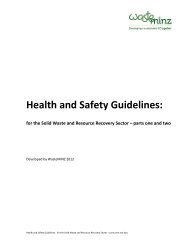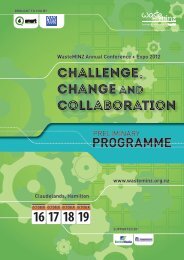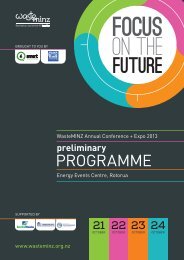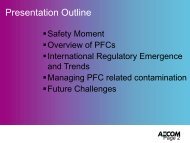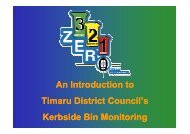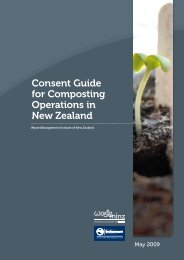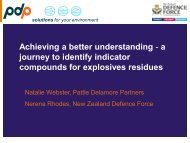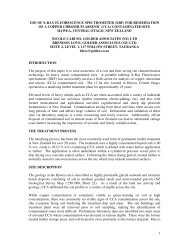Development and implementation of complex ... - WasteMINZ
Development and implementation of complex ... - WasteMINZ
Development and implementation of complex ... - WasteMINZ
- No tags were found...
You also want an ePaper? Increase the reach of your titles
YUMPU automatically turns print PDFs into web optimized ePapers that Google loves.
Large scale investigations<br />
– <strong>Development</strong> & <strong>implementation</strong> <strong>of</strong> <strong>complex</strong> methodologies<br />
Rachel Pickett, Tonkin <strong>and</strong> Taylor<br />
Introduction<br />
New Zeal<strong>and</strong> has provided a number <strong>of</strong> recent examples where large urban areas have<br />
required investigation. These areas create a number <strong>of</strong> challenging obstacles to<br />
overcome <strong>and</strong> highlight the need for early planning <strong>and</strong> regular communication with<br />
stakeholders.<br />
These investigations can be difficult to plan <strong>and</strong> may require the use <strong>of</strong> a number <strong>of</strong><br />
different techniques to collect <strong>and</strong> collate useful data for decision makers.<br />
Framed around two recent examples <strong>of</strong> large-scale projects where large amounts <strong>of</strong><br />
data have been collected. This paper looks at the importance <strong>of</strong>:<br />
- planning an investigation from an early stage;<br />
- development <strong>and</strong> use <strong>of</strong> different methodologies including questionnaires <strong>and</strong><br />
interviews;<br />
- collating large quantaties <strong>of</strong> data;<br />
- the importance <strong>of</strong> talking to people to gain relevant information; <strong>and</strong><br />
- regular communication with clients <strong>and</strong> stakeholders; <strong>and</strong><br />
- lessons learnt<br />
Case Study 1: LDAT Team Christchurch<br />
Following the events <strong>of</strong> 4 September 2010 in Christchurch the EQC quickly had to<br />
exp<strong>and</strong> their team <strong>of</strong> assessors from 29 full time staff to over 1300. The L<strong>and</strong> Damage<br />
Assessment Team or LDAT was rapidly formed, managed by Tonkin <strong>and</strong> Taylor. The<br />
LDAT team ultimately pooled more than 400 specialists from 39 consultancies to<br />
provide <strong>and</strong> report on assessments for over 65,000 Christchurch <strong>and</strong> Kaiapoi properties<br />
from September 2010 to December 2011.
Rapid broad scale assessments were undertaken in the days following the quakes using<br />
aerial photographs, LIDAR 1 data <strong>and</strong> on-ground damage reporting. This information<br />
helped to create the first versions <strong>of</strong> the damage maps. Mapping <strong>of</strong> the severity <strong>of</strong> l<strong>and</strong><br />
damage determined the areas that needed more detailed individual property<br />
inspections (T&T, 2012). These provided the primary targets for the first <strong>of</strong> the LDAT<br />
teams on the ground. The teams then progressively moved outwards. Eventually LDAT<br />
teams were dispatched across the whole <strong>of</strong> the city, <strong>and</strong> on any given day 40 to 45<br />
teams could be found anywhere from North New Brighton to the Port Hills.<br />
The LDAT team modified an original EQC form to a more detailed site assessment<br />
questionnaire to ensure the correct information was collected. In the following months<br />
this questionnaire underwent three major changes. The primary reasons for these<br />
changes were that the role <strong>of</strong> the l<strong>and</strong> assessor <strong>and</strong> the way the information was to be<br />
used became more defined, <strong>and</strong> minor changes were made to provide more consistent<br />
information. L<strong>and</strong> <strong>and</strong> limited building damage information was collected. Template<br />
questionnaires/forms included the types <strong>of</strong> l<strong>and</strong> damage identified for the Plains <strong>and</strong><br />
for the Port Hills. In addition a site plan containing a recent aerial photograph was used<br />
to sketch the location <strong>of</strong> any observed l<strong>and</strong> effects for each individual property.<br />
EQC LDAT assessed properties in the affected areas based on physical address,<br />
regardless <strong>of</strong> whether there was an EQC claim lodged. This was done because more<br />
than 90 percent <strong>of</strong> the properties in the worst affected suburbs had lodged an EQC claim<br />
for at least one <strong>of</strong> the main earthquakes. It was, therefore more efficient to assess<br />
properties by going house-to-house, rather than only inspecting properties around<br />
Christchurch once a claim for l<strong>and</strong> damage was received by EQC (T&T, 2012).<br />
Teams <strong>of</strong> two were given a list with a number <strong>of</strong> properties on a particular street to visit<br />
each day. No appointments were made with the residents <strong>and</strong> assessors were expected<br />
to enter all the properties on the list without prior warning. This meant that it was<br />
important that the assessors were well mannered <strong>and</strong> well informed. Reactions <strong>of</strong> the<br />
1 LIDAR - Light Detection And Ranging. This technology uses ultraviolet, visible, or near infrared light to<br />
image objects <strong>and</strong> measure distance. Typically the laser sensor is mounted on a plane (or satellite) <strong>and</strong><br />
flown over the target area. The sensor emits a light beam <strong>and</strong> records the returned signals. The<br />
differences in each signal's return time, signal strength, <strong>and</strong> x, y, z co-ordinates are captured for later data<br />
processing (NZ Geospatial Strategy).
public were mixed from those that were happy to see us <strong>and</strong> very helpful to those that<br />
became upset or angry. In the case <strong>of</strong> the angry/upset sometimes you could talk to the<br />
residents calmly, explain what you were doing <strong>and</strong> why it needed to be done <strong>and</strong><br />
undertake the assessment, other assessments had to be terminated <strong>and</strong> followed up<br />
with at a later date. There was no time constraint, most properties took around 30<br />
minutes, however for properties that had large or multiple retaining walls, or had<br />
sustained a significant amount <strong>of</strong> damage, assessments could take longer.<br />
There were a number <strong>of</strong> observations made during the course <strong>of</strong> this investigation:<br />
- All staff underwent empathy training with a psychologist in preparation to h<strong>and</strong>le<br />
stressed <strong>and</strong> emotional people. This included how to deal with upset <strong>and</strong>/or angry<br />
people, i.e. apologize <strong>and</strong> walk away/ stay <strong>and</strong> help if possible. There are many<br />
stories - one assessor spent the entire day with one lonely scared lady, even staying<br />
for dinner that night.<br />
- Not all people are suited to undertake this type <strong>of</strong> work. Some assessors lacked the<br />
social skills required to h<strong>and</strong>le upset owners. Often it required someone who had<br />
an approachable manner, good interpersonal <strong>and</strong> communication skills, was able to<br />
read peoples emotions, had a sound underst<strong>and</strong>ing <strong>of</strong> what was happening (in<br />
general), <strong>and</strong> how the information was to be used.<br />
- Due to the large number <strong>of</strong> assessors the questionnaires had to be rigorously<br />
st<strong>and</strong>ardized to ensure that the right data was collected <strong>and</strong> that there was enough<br />
information on each property.<br />
- Teams worked in pairs <strong>and</strong> this was important, not just for personal safety but also<br />
for dealing with the public. Typically one assessor would talk to the resident while<br />
the other assessed the damage.<br />
- Assessments were peer reviewed every day <strong>and</strong> a debrief session was held at the<br />
end <strong>of</strong> each day. This meant that if any problems arose in what was being recorded,<br />
how it was recorded, or if any additional data/modification were required to the<br />
assessment sheets they could be implemented immediately.<br />
- Aerial photographs were provided to record site features on but there were<br />
different interpretations on the detail <strong>of</strong> information required. It is essential to be<br />
specific with regard to the type <strong>of</strong> additional information that is meaningful.
From the late 1800s until around the early 1940s mine tailings <strong>and</strong> mullock from the<br />
local mines <strong>and</strong> stamper batteries was dumped on the foreshore. A seawall formed<br />
around these tailings was constructed as part <strong>of</strong> the Thames Harbour Board works in<br />
the 1920s. The l<strong>and</strong> within the seawall continued to be reclaimed in the 1950s <strong>and</strong> 60s<br />
using weathered local rock. This second stage <strong>of</strong> reclamation was reportedly capped<br />
with clay prior to housing development.<br />
A Ministry for the Environment (MfE) Report from 2001 identified the subdivision as<br />
been constructed from mine tailings <strong>and</strong> the author <strong>of</strong> the report identified these<br />
tailings as a potential source <strong>of</strong> contamination for the Firth <strong>of</strong> Thames. The Waikato<br />
Regional Council became aware <strong>of</strong> this report in 2006. Following this, limited soil<br />
testing was undertaken at the Moanataiari Primary School in 2007. This assessment<br />
reported that the presence <strong>of</strong> a clay cap, soil test results <strong>and</strong> healthy vegetation<br />
indicated that there was no immediate health risk to residents (WRC, 2012).<br />
A preliminary site investigation was undertaken across the Moanataiari subdivision in<br />
October 2011 testing publically accessible l<strong>and</strong>. This testing indicated that the soil<br />
contained elevated levels <strong>of</strong> arsenic, lead <strong>and</strong> antimony (PDP, 2011).<br />
In November 2011 a public meeting was held to inform Moanataiari residents about the<br />
situation <strong>and</strong> inform them <strong>of</strong> the next steps. The council also provided health advice on<br />
how they should manage risks from potential arsenic exposure.<br />
A request for tender to investigate the subdivision was sent out to consultants in 2011.<br />
As part <strong>of</strong> this tender there was a requirement for community liaison. To achieve this<br />
aspect <strong>of</strong> the work we made appointments to talk to each <strong>of</strong> the l<strong>and</strong>owners/residents.<br />
We felt this aspect helped the l<strong>and</strong> owners feel involved in the process <strong>and</strong> gave them<br />
the opportunity to have someone personally explain the process <strong>and</strong> answer any<br />
questions or concerns they had at the time. We also attended weekly community<br />
meetings to answer any technical questions that arose. This helped assure the<br />
community to feel like they were being heard, kept them up to date with how the<br />
project was progressing, <strong>and</strong> later helped when we had to explain methods <strong>of</strong> l<strong>and</strong><br />
remediation.<br />
One <strong>of</strong> the vital parts <strong>of</strong> this project was the questionnaire/interview process. This<br />
provided the main source <strong>of</strong> information regarding how people used their property e.g.
did their children play outside, how much <strong>of</strong> their diet consisted <strong>of</strong> produce sourced<br />
from their gardens.<br />
The questionnaire was carefully planned <strong>and</strong> structured so that all the information<br />
required from the residents was collected at one time, meaning that there was limited<br />
interruption to day-to-day living. The staff undertaking the interviews had previous<br />
experience in carrying out this type <strong>of</strong> work. They also had a good underst<strong>and</strong>ing <strong>of</strong><br />
what information was required, how it was going to be used <strong>and</strong> a contact at the council<br />
to direct residents to if there were any questions that they could not answer. The first<br />
step <strong>of</strong> the interview process was spent clearly explaining to the resident the process <strong>of</strong><br />
what was planned, why the information was required <strong>and</strong> what they could expect in the<br />
coming months.<br />
The only additional work that was not collected at the time <strong>of</strong> the interview was related<br />
to providing an accurate percentage <strong>of</strong> ground cover. Estimates were made during the<br />
initial site visit but an additional, more accurate, number was generated using aerial<br />
photographs to estimate remedial costs.<br />
The data collected from the interviews <strong>and</strong> questionnaires was then inputted into an<br />
excel spreadsheet so that it could be analysed.<br />
Lesson’s Learnt<br />
LDAT<br />
<br />
<br />
<br />
Be specific as to the amount <strong>and</strong> type <strong>of</strong> additional information required, this can<br />
be especially important on aerial photographs/plans;<br />
If you are working with a large number <strong>of</strong> individuals, these individuals should<br />
undergo an assessment to ensure that they a) are competent <strong>and</strong> have a grasp <strong>of</strong><br />
what information needs to be recorded <strong>and</strong> b) have the interpersonal skills to<br />
communicate well with both their team members <strong>and</strong> with the public. And at the<br />
very least provide a set <strong>of</strong> questions that could be asked to get any additional<br />
information;<br />
Having the residents/owners there was invaluable in allowing the assessor to<br />
make an accurate deduction <strong>of</strong> what had occurred on their property. It also<br />
allowed for the assessor to establish what damage had occurred inside the<br />
buildings to potential identify l<strong>and</strong> damage beneath the building;
If you are carrying out an assessment without an appointment <strong>and</strong> in the absence<br />
<strong>of</strong> the resident/owner leave a card or form saying that someone had been in to<br />
assess their property <strong>and</strong> provide links to where to find additional information.<br />
Most importantly this card could show who we were <strong>and</strong> what they could expect<br />
(we were EQC assessing the l<strong>and</strong> only, there were other people around doing this<br />
<strong>and</strong> that etc. <strong>and</strong> what would happen with the information we had gathered).<br />
For large areas such as Christchurch, provide an updated publicly viewable map<br />
showing progress so that people could see what was happening <strong>and</strong> where we<br />
were, again, if they understood what was happening <strong>and</strong> were left in the dark as<br />
little as possible they were much more underst<strong>and</strong>ing towards us <strong>and</strong> our goals.<br />
Moanataiari<br />
<br />
<br />
<br />
<br />
Be consistent with regard to filling in the questionnaire. In this case it was easy<br />
as there was only two people completing the forms had a clear underst<strong>and</strong>ing <strong>of</strong><br />
what was required <strong>and</strong> both <strong>of</strong> the staff had previous experience in the area;<br />
The client had provided contact cards <strong>and</strong> a contact number so that if there were<br />
questions that the assessors could not answer or queries that arose following the<br />
interview somebody was available to answer them. We felt this helped to<br />
alleviate any concerns <strong>of</strong> the residents <strong>and</strong> provided additional support if they<br />
felt they needed it;<br />
It may seem like a simple investigation, but when there are over two hundred<br />
properties involved it is vital that there are good systems in place with regard to<br />
record keeping <strong>and</strong> tracking <strong>of</strong> information, budgets, <strong>and</strong> progress – be<br />
organized; <strong>and</strong><br />
Community consultation from the onset <strong>of</strong> the investigation helped to ensure the<br />
residents to feel they have had the opportunity to have their say. However it is<br />
vital that as a consultant you stick to the facts <strong>and</strong> your area <strong>of</strong> expertise. It is<br />
very easy to be drawn <strong>of</strong>f on tangents about unrelated topics.<br />
Future developments<br />
Ideally given the size <strong>and</strong> nature <strong>of</strong> the LDAT project it would have been convenient to<br />
make use <strong>of</strong> available technology e.g. to have the form section on a tablet <strong>and</strong> the sketch<br />
section done by h<strong>and</strong>. This would have alleviated the illegible writing <strong>and</strong> made it
faster for data input processes. However, in reality on a large project such as this it<br />
would have taken too long to type out the communication with the residents/owners or<br />
any <strong>of</strong> the larger h<strong>and</strong>writing sections, the assessors would have required additional<br />
training <strong>and</strong> the tablets would have required constant maintenance. The use <strong>of</strong> this<br />
type <strong>of</strong> data collection would probably only work well if prior testing had been<br />
undertake to iron out any bugs.<br />
Some aspects <strong>of</strong> these projects may have also been made easier if plans <strong>and</strong> aerial<br />
photographs were available in an electronic format where other features such as<br />
topographic maps, streambeds, areas could be accessed. It would have also made plans<br />
easier to decipher i.e. use <strong>of</strong> blue or black pen over dark areas, <strong>and</strong> clear annotated<br />
notes.<br />
Producing a questionnaire <strong>and</strong> conducting interviews<br />
When creating a questionnaire it is important to have a clear aim <strong>and</strong> objective <strong>of</strong> what<br />
information you think you require.<br />
May only use 5% <strong>of</strong> the information that you collect, but at the outset we don’t always<br />
know what information will become important.<br />
Think about how you plan to use the data you collect, whether it will need to be<br />
transposed or analysed, these things can take significant time<br />
The simplest method is a spreadsheet like excel. This allows data entry responses to be<br />
coded <strong>and</strong> can allow for statistical analyses quickly <strong>and</strong> simply, if required<br />
Be careful how questions are worded <strong>and</strong> what you are asking, sometimes it is the<br />
simplest questions which may <strong>of</strong>fend e.g. how long have you lived in this house?<br />
Be careful <strong>of</strong> leading questions, assuming opinions, <strong>and</strong> vague questions.<br />
If you are planning to undertake interviews as part <strong>of</strong> your investigation, we<br />
recommend that you consider the following:<br />
- The population you are targeting; are they elderly, working, parents?<br />
- The time <strong>of</strong> day;<br />
- Number <strong>of</strong> questions;<br />
- Number <strong>of</strong> open questions; these can take a long time to answer <strong>and</strong> can become<br />
difficult to transcribe correctly; <strong>and</strong>
- How you plan to collate <strong>and</strong> transcribe the information<br />
Conclusion<br />
Investigation <strong>of</strong> developed areas with a large number <strong>of</strong> residents has the advantage<br />
that there is a rich source <strong>of</strong> information available. Gathering this data in a useful <strong>and</strong><br />
sensitive manner is a skill, <strong>and</strong> one not every contaminated l<strong>and</strong> practitioner or<br />
engineer may necessarily have. Care needs to be taken in selecting the interviewers <strong>and</strong><br />
the questionnaire methodology to ensure that the gathered data has the maximum<br />
usefulness <strong>and</strong> that the residents have the opportunity to ask questions. It is important<br />
to remember that the information exchange has to work both ways.<br />
DISCLAIMER<br />
Opinions expressed in this paper are those <strong>of</strong> the author <strong>and</strong> should not be taken in any<br />
way as representing the view <strong>of</strong> Tonkin <strong>and</strong> Taylor Ltd.
Appendix A: Summary table <strong>of</strong> both case studies<br />
LDAT Christchurch<br />
Emergency situation – questionnaire<br />
evolved over time with three major<br />
changes<br />
Public were not informed prior to<br />
individual assessments.<br />
No time limits.<br />
Assessments generally took around 30<br />
minutes dependent on the size <strong>of</strong> the<br />
property, damage <strong>and</strong> the resident<br />
Undertaken in pairs<br />
Total team <strong>of</strong> ~400<br />
Reviewed every day <strong>and</strong> followed up if<br />
information was missing<br />
No consultation undertaken. All<br />
information provided by public notices<br />
or the recovery website<br />
Moanataiari Subdivision<br />
Planned clearly from the onset <strong>of</strong> the<br />
project<br />
Residents were informed prior to the<br />
assessments <strong>and</strong> an appointment was<br />
made to visit each property.<br />
Limited time.<br />
Each assessment was undertaken in 15<br />
minutes.<br />
Assessment undertaken individually<br />
Total team <strong>of</strong> 2<br />
Reviewed once all properties assessed<br />
– missing information was not picked<br />
up until much later.<br />
Community consultation undertaken<br />
from the beginning
Appendix B: References<br />
T&T, July 2012. Earthquake Commission – Canterbury earthquakes 2010 <strong>and</strong> 2011 l<strong>and</strong><br />
report as at the 29 February 2012.<br />
New Zeal<strong>and</strong> geospatial strategy, 2012. Collating NZ’s LiDAR data<br />
http://www.geospatial.govt.nz/<br />
CSI, June 2010. Moanataiari Subdivision, Thames, scoping report – historical<br />
contamination review.<br />
PDP, December 2010. Moanataiari Subdivision site investigation report.<br />
Waikato Regional Council, 2012. Timeline: history <strong>of</strong> the subdivision <strong>and</strong> project<br />
http://www.waikatoregion.govt.nz/Community/Whats-happening/Moanataiari-subdivision/



